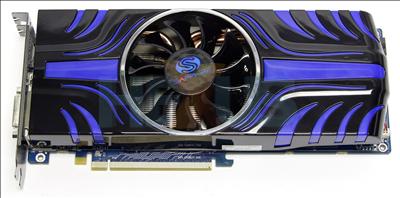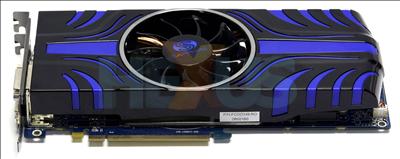The card
The reference card's vital stats show that it clocks in at 725MHz engine and 4,000MHz GDDR5 memory. Coupled to 1,440 stream processors and 72 texture-units, base performance is around 75 per cent of the HD 5870 part.The Vapor-X arrives with speeds of 735MHz/4,200MHz - the barest of overclocks, really - whilst the TOXIC races on by at 765MHz engine and 4,500MHz memory, putting its guaranteed speeds on the high side of what other partners such as XFX and MSI are offering with their pre-overclocked HD 5850s.
We're looking at the TOXIC card here, but, tellingly, both special-edition models use exactly the same cooler and PCB. They differ from the reference design in a number of ways. The PCB and layout are both marginally different; Sapphire adds in its own chokes for, it says, better reliability.
The use of an identical cooler means that the cards are speed-graded after production, and those that manage 765MHz/4,500MHz are marked-up as TOXIC. We imagine that the price premium between the two will be around £20 for, on paper, a four per cent increase in engine speed and seven per cent on the memory.
Sapphire needs to ensure that pricing for this model is no more than £270, knowing that a stock-clocked HD 5870 - an intrinsically better GPU in terms of performance - is available for £320 from most etailers, with some having it on week-long specials at £299.99.
The reference design's fan spins at around 1,135rpm when idling and 2,200rpm when under load. What the numbers don't tell you is that the under-load sound is noticeable in a quiet system; the fan makes what can be described as a constamt 'whooshing' sound.
Sapphire's card has an 88mm fan that rotates at 1,066rpm and 2,010rpm when idle and under-load, respectively, but is considerably quieter when running at full tilt. Indeed, we had to stop the system CPU's fan to determine whether the near-doubling of the TOXIC's fan-speed made any real-world difference to the noise.
A blue-coloured PCB fits in with the overall aesthetic. It's no different to the reference card's in any meaningful way, including size. For those that want to know, the card weighs 683g, compared to the AMD-supplied HD 5850 at 858g.
The four-pin fan-connector means that the fan-speed modulates in accordance with temperature. It takes around 30 seconds to drop from the under-load 2,010rpm to <1,100rpm once you have exited a game.
The PCB is 12mm longer than a generic Radeon HD 5850's, measuring 256mm in length. Appreciating that some folk don't have cavernous chassis, we'd have recommended Sapphire house the twin six-pin power connectors on one side rather than directly infront.
The rear section is identical to any found on the Radeon HD 5800-series cards. The cooler doesn't exhaust anywhere near as much hot air out of the back as a reference HD 5850. Rather, the GPU-transferred heat feels as if it's circulating around the card and inside the chassis.
Summary
Now that AMD has opened up the floodgates by letting partners design their own Radeon HD 5850 offerings, Sapphire's Vapor-X and TOXIC both use a better-than-reference cooler and ship with pre-overclocked engine and memory speeds on both counts.















